

Tips for Writing Instructional Objectives - Bloom's Taxonomy Job Aids. I am so delighted to see this post that includes Bloom's Taxonomy Wheels by ZaidLearn.
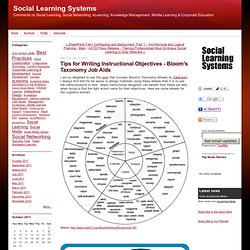
I always find that it's far easier to design materials using these wheels than it is to see the verbs/products in lists. Many instructional designers can benefit from these job aids when trying to find the right action verbs for their objectives. Here are some wheels for the cognitive domain. Source: Source: Source: Bloom’s digital taxonomy. Have fun, designers! Blooms-quick sheets. The Best Resources For Helping Teachers Use Bloom’s Taxonomy In The Classroom. Bloom’s & SOLO ‘are not Just Colorful Posters we Hang on the Wall’ is my two-part series at Education Week Teacher.

Bloom’s Taxonomy is talked about a lot in educational circles. However, if you believe a recent survey of visits to 23,000 U.S. classrooms, the higher-order thinking skills it’s ideally designed to promote doesn’t get much use. And I can understand why. It’s easy to get caught-up in the day-to-day work involved in teaching a class or multiple classes, and it’s easy to fall into the trap of doing the “usual stuff” and not “think out of the box.”
Six Vintage-Inspired Animations on Critical Thinking. Patterns: Learning, Thinking, Creating. By Kevin Washburn, on January 10th, 2012 It seems contradictory.
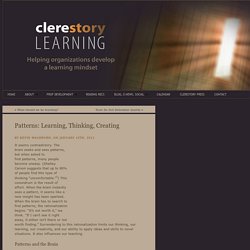
The brain seeks and sees patterns, but when asked to find patterns, many people become uneasy. (Shelley Carson suggests that up to 80% of people find this type of thinking “uncomfortable.”1) This conundrum is the result of effort. When the brain instantly sees a pattern, it seems like a new insight has been sparked.
When the brain has to search to find patterns, the rationalization begins. Patterns and the Brain “Patterns” was a major theme at the November Learning and the Brain Conference in Boston. Patterns are the cement of memory. Free Online Tools to Create Infographics. Infographics and data visualizations have become incredibly popular ways to impart information while keeping your audience engaged.
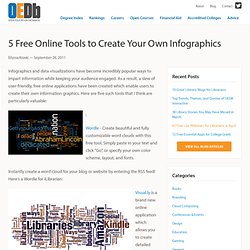
As a result, a slew of user-friendly, free online applications have been created which enable users to create their own information graphics. Here are five such tools that I think are particularly valuable: Wordle - Create beautiful and fully customizable word clouds with this free tool. Simply paste in your text and click “Go”, or specify your own color scheme, layout, and fonts. Instantly create a word cloud for your blog or website by entering the RSS feed!
Visual.ly is a brand new online application which allows you to create detailed data visualizations and infographics such as the one below. Twitter Visualizer – This fun tool quickly creates a personalized infographic of your Twitter persona based on what you tweet. Creately let’s you build organized concept maps, flowcharts, and diagrams for free. Six Thinking Hats® Six Hats® ...
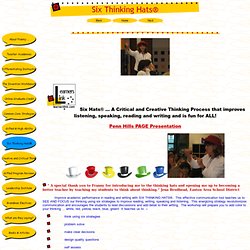
A Critical and Creative Thinking Process that improves listening, speaking, reading and writing and is fun for ALL! Penn Hills PAGE Presentation " A special thank you to Franny for introducing me to the thinking hats and opening me up to becoming a better teacher by teaching my students to think about thinking. " Jena Brodhead, Easton Area School District Improve academic performance in reading and writing with SIX THINKING HATS®. Think using six strategies problem solve make clear decisions design quality questions self assess collaborate more effectively The Research -- "Develop Critical and Creative Thinking Skills: Put on Six Thinking Hats®," PA Educational Leadership. Exploratree - Exploratree by FutureLab. Teaching-with-Technology - Promotingthinking. Kathy Schrock's Guide to Everything.
Are You Left or Right Brain? It Is Not About the Gadgets - Why Every Teacher Should Have to Integrate Tech Into Their Classroom. The Best Places To Create (And Find) Internet Scavenger Hunts & Webquests. There seems to be a fair amount of confusion about the definition of a “Webquest.”

Bernie Dodge, who originated the model in 1995, described it like this in a comment on this blog last year: “A critical attribute of a WebQuest is that it engages higher level thinking, the upper part of Bloom’s taxonomy. Things like creativity, analysis, synthesis. judgment…. Top 5 Websites for Teachers to Use in Their Classrooms. Effective Digital Learning. I was asked yesterday what I considered to be the four components of effective digital learning.
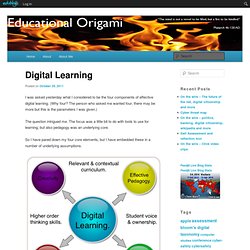
(Why four? The person who asked me wanted four, there may be more but this is the parameters I was given.) The question intrigued me. The focus was a little bit to do with tools to use for learning, but also pedagogy was an underlying core. So I have pared down my four core elements, but I have embedded these in a number of underlying assumptions. The underlying assumptions are core values and processes that enable Digital learning to flourish. A relevant and contextual curriculumAssessment that is both challenging and transparent (since this lies in a relevant and contextual curriculum, it is also by definition relevant and contextual)An emphasis of higher order thinking skills (analysis and evaluation – creativity is a core aspect of Digital learning)Valuing student voice and providing the students with ownership of their learning and assessment.